Original Title: "Buying Coins: The New Wealth Code for US Listed Companies"
Original Source: Deep Tide TechFlow
On May 27, a little-known stock stirred up a huge wave in the Nasdaq trading hall. SharpLink Gaming (SBET), a small gambling company with a market value of only $10 million, announced it had acquired approximately 163,000 Ethereum (ETH) through a $425 million private equity investment. Upon the news, SharpLink's stock price skyrocketed, with an increase of over 500% at one point.
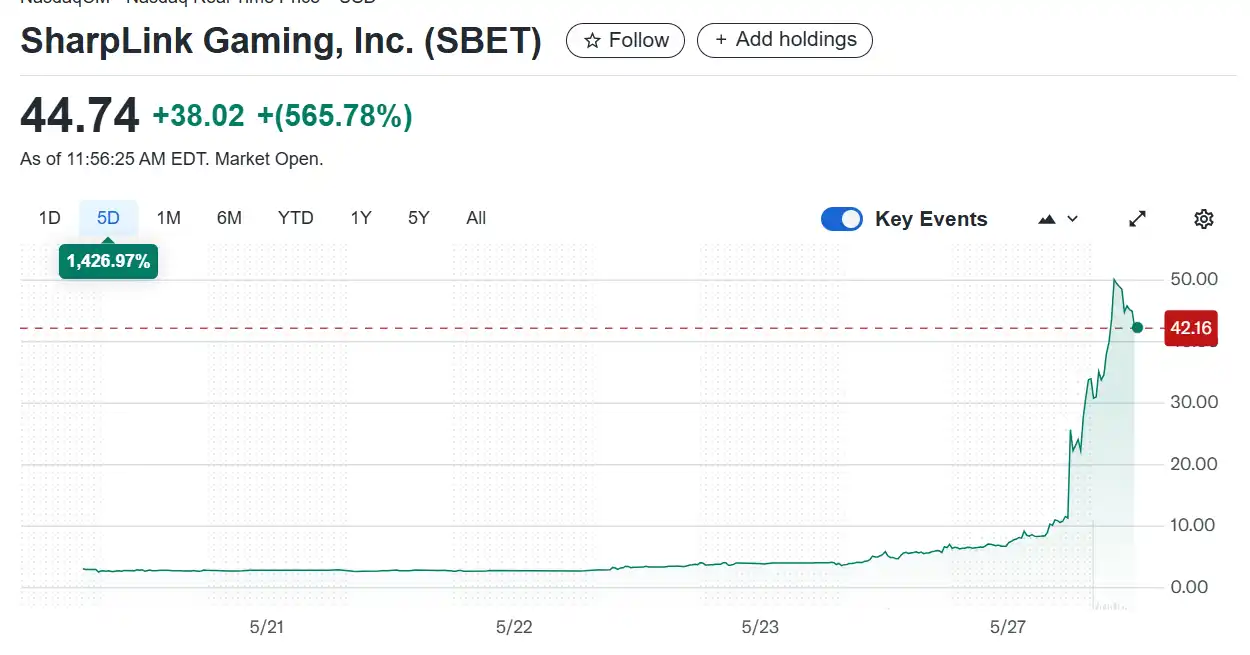
Buying coins may be becoming the new wealth code for US listed companies to boost stock prices. The story naturally begins with MicroStrategy (now renamed Strategy, stock code MSTR), the company that first ignited the flames by boldly betting on Bitcoin back in 2020. Over five years, it transformed from an ordinary tech company into a "Bitcoin investment pioneer." In 2020, MicroStrategy's stock price was just over $10; by 2025, it had soared to $370, with a market value exceeding $100 billion.
Buying coins not only inflated MicroStrategy's balance sheet but also made it a darling of the capital markets. By 2025, this trend intensified. From tech companies to retail giants and small gambling enterprises, US listed companies are igniting a new engine of valuation with cryptocurrencies. What are the secrets behind the wealth code of increasing market value through buying coins?
MicroStrategy: A Textbook Case of Coin-Stock Integration
It all started with MicroStrategy. In 2020, this enterprise software company was the first to kick off the buying coin craze in the US stock market. CEO Michael Saylor stated that Bitcoin is "a more reliable store of value than the dollar"; while the faith is exciting, what truly set this company apart was its approach in the capital markets.
MicroStrategy's strategy can be summarized as a combination of "convertible bonds + Bitcoin":
First, the company raised funds by issuing low-interest convertible bonds. Since 2020, MicroStrategy has issued such bonds multiple times, with interest rates as low as 0%, far below the market average. For example, in November 2024, it issued $2.6 billion in convertible bonds, with almost zero financing costs. These bonds allow investors to convert them into company stock at a fixed price in the future, effectively giving investors a call option, while allowing the company to obtain cash at a very low cost.
Second, MicroStrategy invested all the raised funds into Bitcoin. By continuously increasing its Bitcoin holdings through multiple rounds of financing, Bitcoin became a core component of the company's balance sheet.
Finally, MicroStrategy leveraged the premium effect brought by the rising Bitcoin prices to initiate a "flywheel effect."
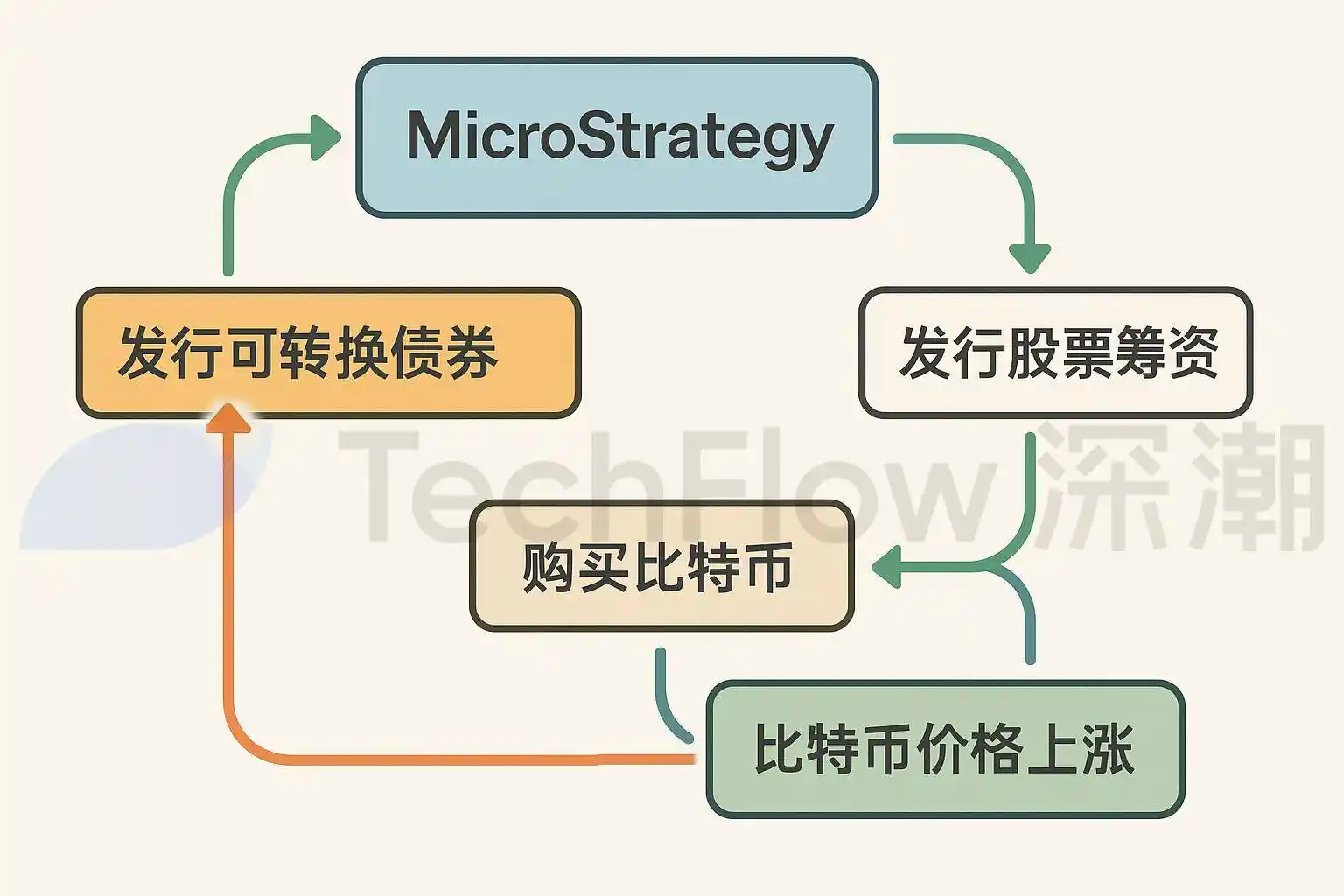
As Bitcoin's price rose from $10,000 in 2020 to $100,000 in 2025, the company's asset value significantly increased, attracting more investors to buy its stock. The rise in stock prices allowed MicroStrategy to issue bonds or stocks again at a higher valuation, raising more funds to continue purchasing Bitcoin, thus forming a self-reinforcing capital cycle.
The core of this model lies in the combination of low-cost financing and high-return assets. By borrowing money at nearly zero cost through convertible bonds, buying volatile but bullish Bitcoin in the long term, and then amplifying valuations through market enthusiasm for cryptocurrencies. This approach not only changed MicroStrategy's asset structure but also provided a textbook example for other US companies.
SharpLink: The Intent Behind the Shell
SharpLink Gaming (SBET) optimized the above strategy by using Ethereum (ETH) instead of Bitcoin. However, behind this lies a clever combination of crypto power and capital markets.
Its strategy can also be summarized as "shell acquisition," focusing on leveraging the "shell" of a listed company and the crypto narrative to quickly amplify valuation bubbles. SharpLink was originally a small company struggling on the verge of delisting from Nasdaq, with its stock price once below $1 and shareholder equity under $2.5 million, facing significant compliance pressure.
But it had a killer advantage—its Nasdaq listing status. This "shell" attracted the attention of crypto giants: ConsenSys, led by Ethereum co-founder Joe Lubin.
In May 2025, ConsenSys, along with several venture capital firms in the crypto space (such as ParaFi Capital and Pantera Capital), led the acquisition of SharpLink through a $425 million PIPE (private investment in public equity). They issued 69.1 million new shares (at $6.15 per share), quickly taking over more than 90% of SharpLink's control, bypassing the cumbersome processes of an IPO or SPAC. Joe Lubin was appointed as the chairman of the board, and ConsenSys clearly stated it would collaborate with SharpLink to explore the "Ethereum treasury strategy."
Some say this is the ETH version of MicroStrategy, but in reality, the strategy is more sophisticated. The true purpose of this transaction is not to improve SharpLink's gambling business, but rather for it to become a bridgehead for the crypto world to enter the capital markets.
ConsenSys plans to use this $425 million to acquire approximately 163,000 ETH, packaging it as the "Ethereum version of MicroStrategy," and claiming ETH as a "digital reserve asset." The capital market is about "story premium," and this narrative not only attracted speculative funds but also provided institutional investors who cannot directly hold ETH with a "public ETH proxy."
Buying coins is just the first step; SharpLink's real "magic" lies in the flywheel effect. Its operations can be broken down into a three-step cycle:
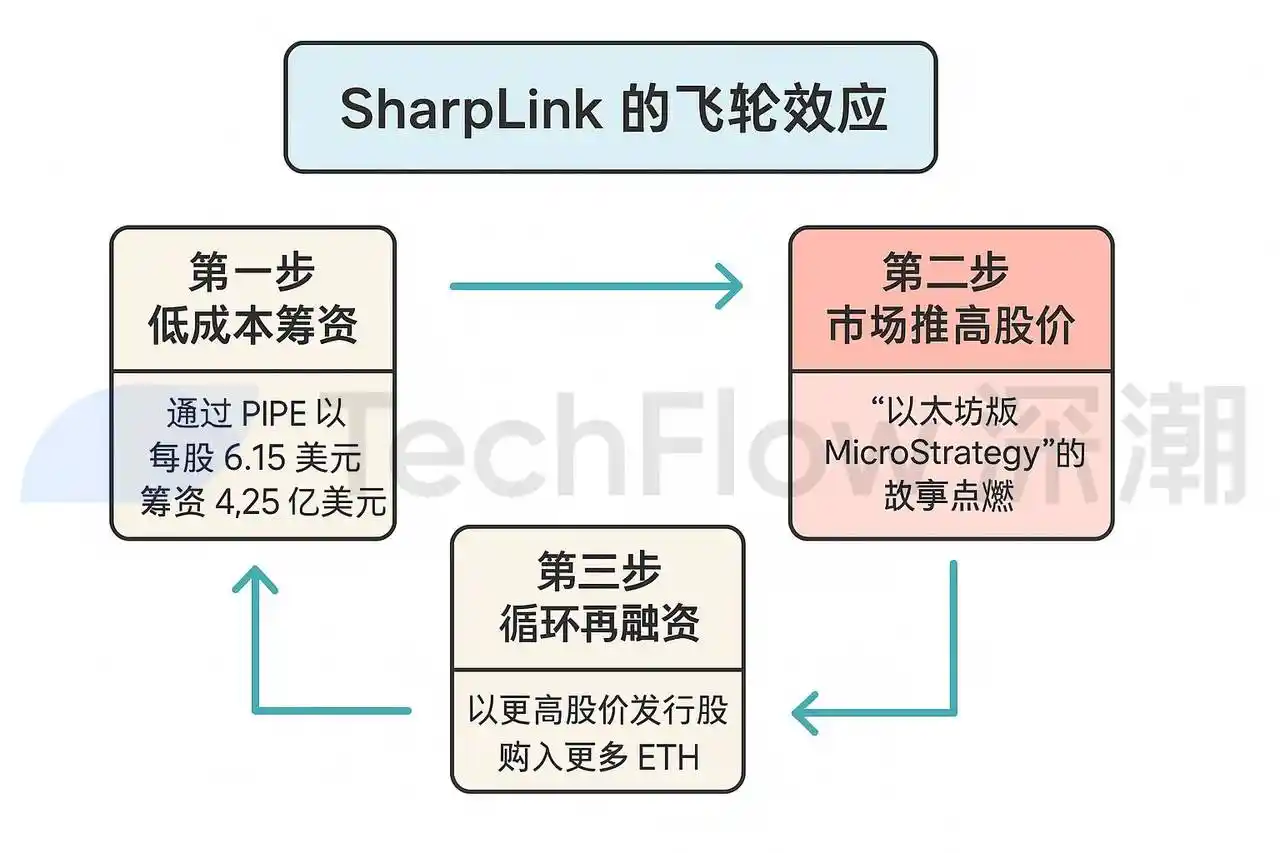
Step 1: Low-cost fundraising.
SharpLink raised $425 million through PIPE at a price of $6.15 per share, which, compared to an IPO or SPAC, requires no cumbersome roadshows and regulatory processes, making it cheaper.
Step 2: Market enthusiasm drives up stock prices.
Investors were ignited by the story of the "Ethereum version of MicroStrategy," and the stock price soared rapidly. The market's enthusiasm for SharpLink's stock far exceeded its asset value, with investors willing to pay far above its net ETH holding value, creating a "psychological premium" that rapidly inflated SharpLink's market value. SharpLink also plans to stake these ETH tokens, locking them in the Ethereum network, earning an annual yield of 3%-5%.
Step 3: Circular refinancing. By issuing stocks again at a higher price, SharpLink can theoretically raise more funds to buy more ETH, repeating the cycle and causing valuations to snowball.
Behind this "capital magic" lies the shadow of a bubble. SharpLink's core business—gambling marketing—has almost no interest, and the $425 million ETH investment plan is completely disconnected from its fundamentals. Its stock price surge is more driven by speculative funds and the crypto narrative.
The truth is, crypto capital can also use the "shell + buying coins" model to quickly inflate valuation bubbles through some small and medium-sized listed companies. The intent behind the shell is not necessarily related to the company's business; if there is a connection, that's great, but if not, it doesn't really matter.
Imitation is Not Always Effective
The buying coin strategy seems to be the "wealth code" for US listed companies, but it is not foolproof. The path of imitation is crowded with latecomers.
On May 28, GameStop, the gaming retail giant that once gained fame for retail investors banding together against Wall Street, announced it would purchase 4,710 Bitcoins for $512.6 million, attempting to replicate MicroStrategy's success. However, the market reacted coldly: after the announcement, GameStop's stock price fell by 10.9%, and investors were not convinced.
On May 15, Addentax Group Corp (stock code ATXG), a Chinese textile and apparel company, announced plans to acquire 8,000 Bitcoins and Trump's TRUMP coin through the issuance of common stock. Based on the current Bitcoin price of $108,000, this purchase cost would exceed $800 million.
However, as a comparison, the company's total stock market value is only about $4.5 million, meaning its theoretical coin purchase cost is over 100 times the company's market value. Almost simultaneously, another Chinese US-listed company, Jiuzi Holdings (stock code JZXN), also joined the buying coin craze. The company announced plans to purchase 1,000 Bitcoins within the next year, costing over $100 million.
Public information shows that Jiuzi Holdings is a Chinese company focused on new energy vehicle retail, established in 2019. Its retail stores are mainly located in third- and fourth-tier cities in China. The company's total stock market value on Nasdaq is only about $50 million.
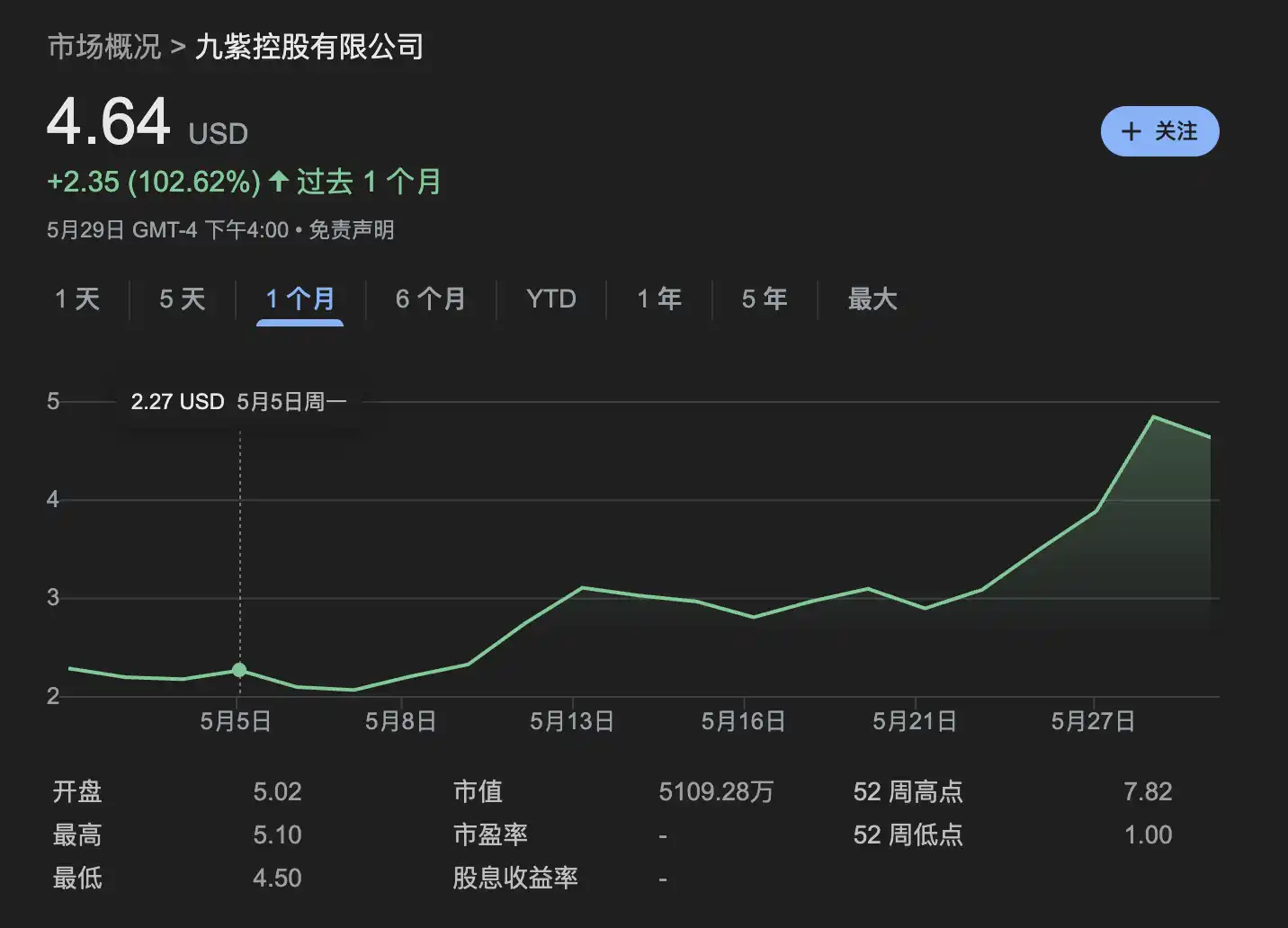
The stock price is indeed rising, but the key is the matching of the company's market value with the coin purchase cost. For more latecomers, if Bitcoin prices fall and they actually buy in, their balance sheets will face enormous pressure. The buying coin strategy is not a universal wealth code. Lack of fundamental support and excessive leverage in buying coins may just lead to a risky path toward bubble collapse.
Another Way to Break Out
Despite the numerous risks, the buying coin craze still has the potential to become the new normal. In 2025, global inflation pressures and expectations of dollar depreciation continue, and more companies are beginning to view Bitcoin and Ethereum as "anti-inflation assets." Japan's Metaplanet has already enhanced its market value through a Bitcoin treasury strategy, while more US listed companies are increasingly following in MicroStrategy's footsteps.
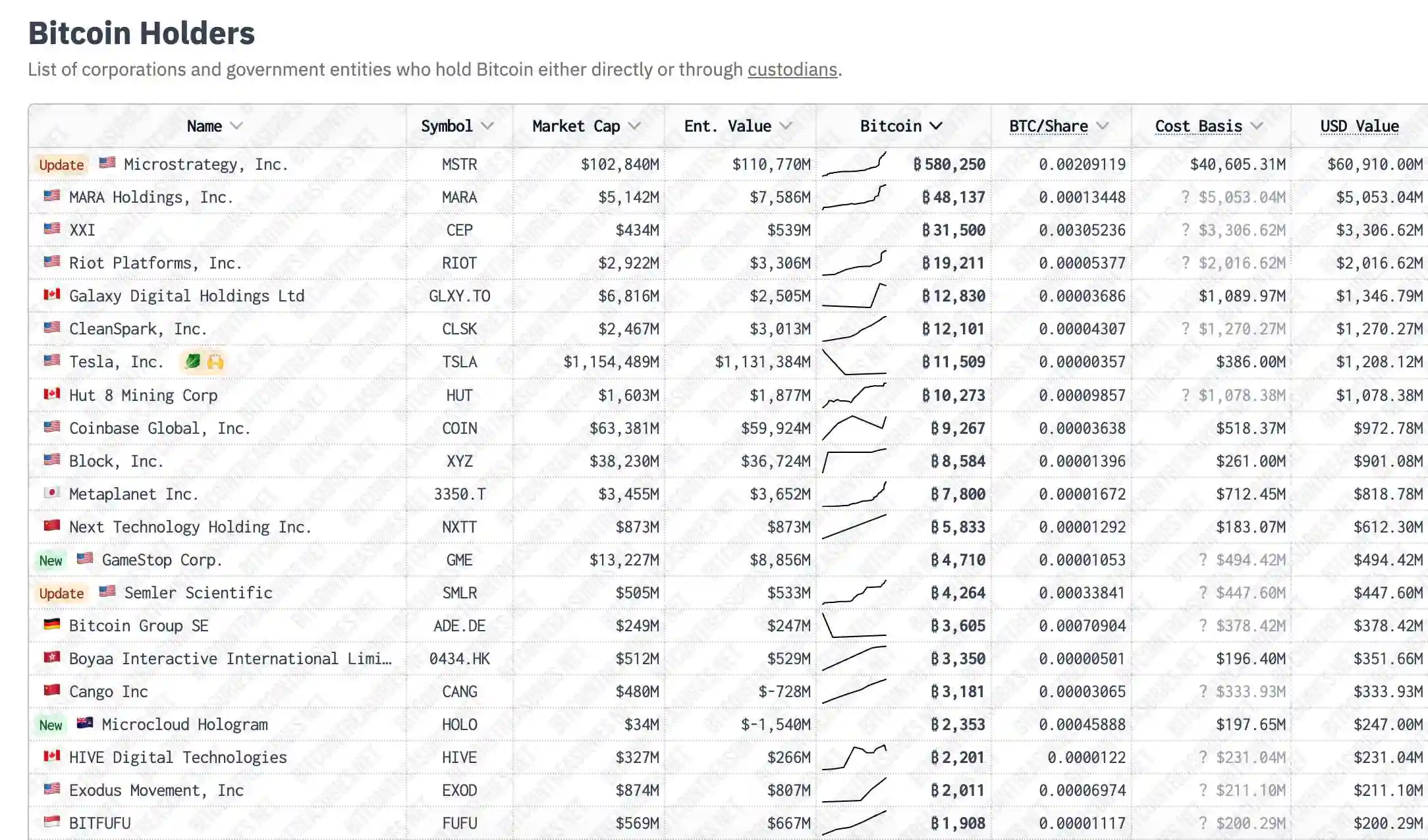
Under the prevailing trend, cryptocurrencies are increasingly making their presence felt in global politics and economics. Is this what people in the crypto world often refer to as "breaking out"? A comprehensive observation of the current trends indicates that the paths for cryptocurrencies to break into the mainstream mainly consist of two: the rise of stablecoins and the crypto reserves on company balance sheets.
On the surface, stablecoins provide a stable medium for payments, savings, and remittances in the crypto market, reducing volatility and promoting widespread adoption of cryptocurrencies. However, their essence is an extension of dollar hegemony. Taking USDC as an example, its issuer Circle has close ties with the US government and holds a large amount of US Treasury bonds as reserve assets. This not only reinforces the dollar's status as a global reserve currency but also further permeates the influence of the US financial system into the global crypto market through the circulation of stablecoins.
The other path to breaking out is the aforementioned buying coins by listed companies. These companies attract speculative funds through crypto narratives, driving up stock prices. However, aside from a few leading companies, it remains a mystery how much improvement in the fundamentals of their main businesses can be achieved by later imitators, aside from increasing market valuations.
Whether it is stablecoins or crypto assets entering company balance sheets, crypto assets appear more as a tool to extend or reinforce the existing financial landscape. Whether it is about being exploited or financial innovation, it resembles two sides of a coin, depending on which side of the table you are sitting on.
免责声明:本文章仅代表作者个人观点,不代表本平台的立场和观点。本文章仅供信息分享,不构成对任何人的任何投资建议。用户与作者之间的任何争议,与本平台无关。如网页中刊载的文章或图片涉及侵权,请提供相关的权利证明和身份证明发送邮件到support@aicoin.com,本平台相关工作人员将会进行核查。




